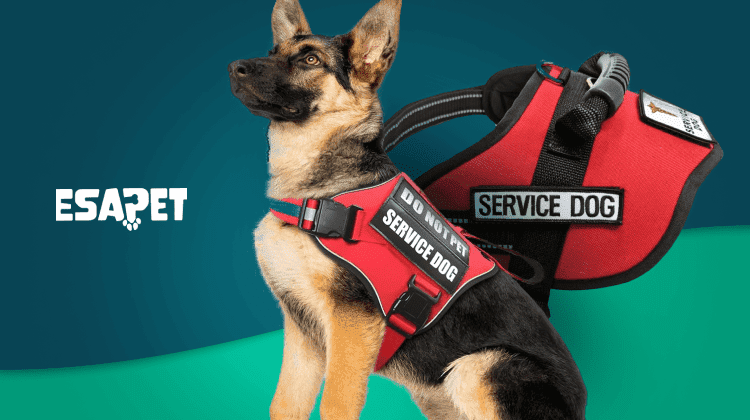How to Get a Psychiatric Service Dog: Certification Tips

Psychiatric service dogs are incredible companions for people dealing with mental health conditions. These dogs are specially trained to perform tasks that make daily life manageable. This article discusses getting a PSD, training, and legal protections for owning one.
What is a Psychiatric Service Dog (PSD)?
A PSD is a specially trained dog that assists individuals with mental illnesses. These animals are trained to perform tasks supporting their handler’s mental health. Unlike emotional support animals, PSDs are trained to take direct action during psychiatric episodes.
While ESAs offer comfort, PSDs have legal rights to go with their handler in public spaces. Their role is crucial for people with psychiatric disabilities. Psychiatric service dogs perform tasks related to their handler’s mental health disability.
Psychiatric Service Dogs Tasks
PSDs are trained to assist individuals with mental health conditions. They perform specific tasks that help manage their symptoms. Psychiatric Service Dog tasks provide immediate support during moments of distress. Below are some common tasks that PSDs are trained to perform.
Interrupting Anxiety or Panic Attacks
A psychiatric assistance dog can sense the onset of anxiety or panic attacks. They interrupt them by nudging, licking, or providing comforting physical contact. This distraction helps the handler refocus and manage their anxiety symptoms.
Providing Deep-Pressure Therapy
Some PSDs are trained to apply deep pressure by lying on their handler’s lap or chest. This pressure has a calming effect. It helps to reduce feelings of anxiety, stress, or sensory overload.
Waking Their Handler from Nightmares
Handlers with conditions like PTSD may experience nightmares or night terrors. PSDs are trained to wake their handler from these distressing dreams by nudging or licking, bringing them back to reality.
Reminding the Handler to Take Medication
PSDs can be trained to alert their handler when it’s time to take prescribed medication. They may do this by bringing the medication container or performing a specific action at the scheduled time. This helps the handler stay on track with their treatment.
Psychiatric Service Dogs vs. Emotional Support Animals
PSDs and ESAs differ in key ways. PSDs undergo specialized training to perform tasks related to a handler’s disability. These tasks help manage conditions like PTSD or anxiety. ESAs provide general emotional comfort but don’t need special training.
Under the Americans with Disabilities Act (ADA), they can access public spaces with their handler. ESAs don’t have the same rights under the ADA. However, both PSDs and ESAs are protected under the Fair Housing Act. This ensures they can live with their handler in housing.
How Psychiatric Service Dogs Help with Specific Mental Health Conditions
PSDs play a crucial role in assisting people with various mental health conditions. Unlike general emotional support animals, PSDs are trained to perform specific tasks. The tasks performed by PSDs can make a significant difference in the lives of individuals.
These dogs help their handlers regain control during difficult moments by responding to specific symptoms. This assistance allows for better coping mechanisms and improved mental health over time.
Different mental health conditions need different types of support, and PSDs are trained accordingly. PSDs are an invaluable resource for those seeking greater independence and stability. Below are examples of how PSDs assist with various mental health conditions.
- PTSD: PSDs interrupt flashbacks by nudging or pawing at their handler. They help reduce hypervigilance by staying close and providing a sense of security.
- Anxiety Disorders: These dogs perform deep pressure therapy to calm their handler during a panic attack. Their presence alone helps reduce anxiety and prevent escalation.
- Depression: For those with depression, PSDs encourage activity. They motivate their handler to get out of bed and engage in daily routines like walking or eating.
- Bipolar Disorder: PSDs can sense mood changes early. They alert their handler, giving them time to manage symptoms and prevent harmful behaviors during mood swings.
- OCD: PSDs help interrupt repetitive behaviors. They use gentle nudges or tactile stimulation to redirect their handler’s attention away from compulsions.
- Panic Disorder: These dogs detect rising anxiety and act before a full panic attack happens. They offer physical contact, which helps ground the person during overwhelming moments.
- Schizophrenia: PSDs help by creating a sense of stability and reality. They offer grounding during hallucinations or delusions and prevent dangerous reactions.
What Mental Health Disorders Qualify for a Psychiatric Service Dog?
Several conditions can qualify someone for a psychiatric service dog. These mental health conditions include Post-Traumatic Stress Disorder (PTSD), various anxiety disorders, depression, bipolar disorder, and Obsessive-Compulsive Disorder (OCD).
A mental illness must limit a person’s ability to function. The dog performs tasks that target the symptoms of the condition. For example, it might calm anxiety or help manage mood swings. Each task is designed to help the handler lead a more stable and independent life.
How to Get a PSD
Getting a PSD can be expensive, but there are ways to reduce or cut costs. Non-profit organizations and service dog adoption programs often help people with mental needs. These groups may provide trained dogs or help cover training expenses.
Local resources are a good place to start when looking for a PSD. Many communities have organizations that specialize in psychiatric service dog training and adoption. You can search online or contact national groups for referrals in your area.
The steps to getting a PSD are simple. First, identify the right dog, then work with a certified trainer. Then, ensure your dog completes training to meet your specific mental needs. Finally, understand local and state regulations. Each step ensures the dog can assist with your condition.
Step 1 – Get a Service Dog
Choosing the right dog is crucial. Look for a dog with a calm temperament, good focus, and the ability to learn service tasks. The dog’s personality and behavior should align with your mental health needs.
Best Psychiatric Service Dog Breeds
Some dog breeds are better suited for psychiatric service work. Their temperament and intelligence make them ideal for the tasks required. Below are some of the best PSD dog breeds:
 |
Labrador Retrievers Labradors are friendly and calm. They excel in providing emotional support and handling high-stress situations. |
 |
Golden Retrievers Golden Retrievers are loyal and gentle. They are easy to train and are naturally good at sensing their handler’s needs. |
 |
Poodles Poodles are intelligent and adaptable. Their keen sense of their handler’s emotions makes them excellent PSDs. |
 |
German Shepherds German Shepherds are highly trainable and protective. They are great for individuals needing a dog to stay alert and assist during emergencies. |
Service Dog Adoption Organizations
Several reputable organizations help with service dog adoption. Groups like Canine Companions, The Assistance Dog United Campaign, and Paws With A Cause specialize in psychiatric service dogs. These organizations often provide trained dogs at low or no cost.
Psychiatric Service Dog Costs
The total cost ranges from $15,000 to $30,000 upfront. This covers adoption fees, training, veterinary care, and certification expenses. The price varies based on the organization, training level, and services offered.
There are ways to reduce these costs. Some non-profit organizations provide fully trained PSDs for $3,000 to $10,000. In some cases, self-training your dog is an option that can lower the total cost. Fundraising can be a helpful option for those unable to pay the full amount.
Step 2 – Train Your Dog as a Service Animal
Psychiatric service dog training involves two key stages. First, the dog must learn basic obedience like sit, stay, and heel. Second, the dog learns task-specific training. The dog learns to help with mental illness. The dog must be individually trained to meet the handler’s needs.
You can choose to self-train or work with a professional trainer. Self-training can save money but requires time and patience. Professional service dog training offers expert guidance and quicker results. Unlike therapy dogs, psychiatric service animals must meet strict standards.
Psychiatric Service Dog Training
Assistance Dogs International, the Psychiatric Service Dog Partners, and Canine Companions offer certified programs. These organizations provide guidance on training, certification, and locating professional trainers. You can also visit the websites of local NGOs for more details.
Step 3 – Get a Psychiatric Service Dog Certification Letter
A legitimate psychiatric service dog certification letter is crucial for legally recognizing psychiatric service animals. This letter must come from a licensed mental health professional. It confirms that your dog helps with mental issues and is necessary for your well-being.
What is a Psychiatric Service Dog Letter?
A psychiatric service dog letter states that your dog assists with your mental health. A licensed mental health professional writes it. The letter must confirm that the dog is needed to manage symptoms. You can get one by speaking to your therapist or psychiatrist.
Get your Official PSD Letter Consultation from a licensed therapist.
Get PSD Letter NowStep 4 – Understand Local and State Regulations
Owning a psychiatric service dog comes with legal responsibilities. It’s essential to know your local and state laws. The Americans with Disabilities Act (ADA) protects your right to bring a service dog into public places. However, local laws may have extra requirements.
Understanding local regulations is key. Different states or cities may have unique rules about service dogs. These rules can affect access to housing, businesses, and public transport. Always research the laws in your area to avoid issues.
Psychiatric Service Dog Local Regulations
Regulations for PSDs can differ by state or city. Some areas may need proof of certification. Others follow federal guidelines under the ADA. It allows psychiatric service animals access to public places. They also ensure housing rights under the FHA.
States with Different Requirements for Service Dogs
Some states need proof of certification for public access training. In Hawaii, Washington, and Wyoming, Service Dogs in Training (SDiTs) do not have public access rights. Alabama, Alaska, Iowa, Montana, and West Virginia do not have laws protecting psychiatric service dogs from harm.
Types of Service Dogs and Their Roles
Service dogs are specially trained to help people with disabilities. Psychiatric service dogs assist those with mental health issues like anxiety or PTSD. Guide dogs help the visually impaired navigate their surroundings. Hearing dogs alert their handler to important sounds like alarms.
Mobility assistance dogs support people with physical disabilities. They help with tasks like providing balance or retrieving items. These assistance animals increase independence and safety. Each type of service dog plays a vital role in improving daily life for their handlers.
Frequently Asked Questions About Psychiatric Service Dog
What Is a Psychiatric Service Dog?
A psychiatric service dog is specially trained to help individuals with mental conditions. These companion animals perform tasks that directly assist with symptoms of disorders. These disorders include anxiety, PTSD, or depression.
How Do I Make My Dog a Psychiatric Service Animal?
To make your dog a psychiatric service animal, they must undergo specialized training. The dog needs to learn tasks that help with your mental health condition. You can either self-train your dog or work with a professional trainer.
What Is the Difference Between an Emotional Support Animals and PSDs?
The key difference is that a psychiatric service dog is trained to perform specific tasks related to mental health. An emotional support animal provides comfort but does not need any specialized training. PSDs are protected under the ADA, allowing access to public spaces, while ESAs are not.
Can Any Dog Breed Be a Psychiatric Service Dog?
Yes. Any dog breed can become a psychiatric service dog. The dog must have the right temperament, be calm and trainable, and perform tasks related to the handler’s mental illness. However, some breeds may be more suited due to their natural disposition.
Final Notes on Getting Psychiatric Service Dogs
Getting a PSD involves several key steps: finding a suitable dog, ensuring it has training, and getting a PSD Letter. Understanding local and state regulations is essential. PSDs provide vital support for individuals with psychiatric disabilities, helping them manage symptoms.










